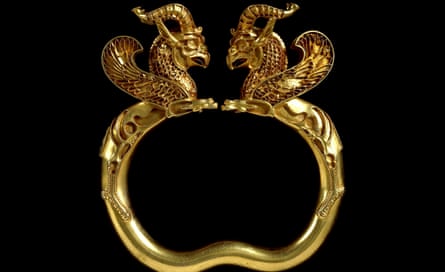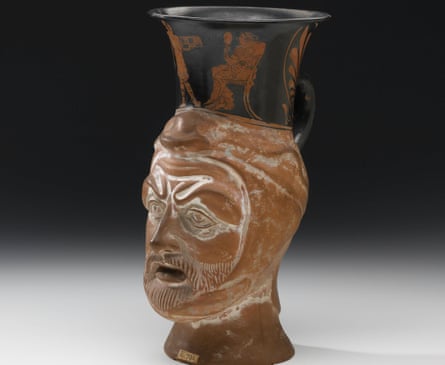A pair of sculpted heads stare at each other at the start of this exhibition: an ancient Persian with a square beard and tight ringlets facing up to the Greek god Apollo. Here is a polarity that has defined global history. The struggle between the Greek city states and the Achaemenid empire was believed by the Greeks to be a fight to establish who they were: western, not eastern, self-governing, and democratic in the case of Athens, as opposed to the playthings of Persian tyrants.
But guess what – the reality was more complicated. The Persian portrait and the Chatsworth Apollo, as it’s known, are not so different. Both come from 5th century BC Cyprus, and are associated with sanctuaries where Apollo and the Persian god Reshef were jointly worshipped.
One thing this exhibition in the BM’s compact Great Court gallery has going for it is clarity. It covers 500 years of Persian and Greek history but instead of an epic, exhausting saga it is more like a brief introduction centred on the theme of luxury. That is a key word in classical historical and political texts, the flaw that corrupts and destroys societies, associated with the east and Persian power. To suggest it, the gallery has been swathed with white draperies and faux columns like a tackily overdone Greek restaurant, or maybe a shop selling repro antiques.

There are three sections: a sort of thesis, antithesis and synthesis. First, we get a taste of the Persian empire, including a relief of Darius I worshipping Anubis in Egyptian style. Then we see how classical Athens wrestled with Persian artistic influence even as it mocked the defeated empire. Finally, the two cultures merge as Alexander the Great conquers Persia yet embraces its ways.
The wars that ancient historians made so much of are relegated to small connecting displays – a Hoplite helmet, sounds of clashing weapons, that’s your lot. It’s more surprising that such short shrift is given to “the Greek historian Herodotos”. It’s oddly pedantic to insist on the Greek version of his name when he’s been famous for centuries as Herodotus. And strange to marginalise the father of history: Herodotus didn’t just tell of Persia’s invasion of Greece and its failure, but also explored the cultures of much of the Greeks’ known world, perhaps even visiting Babylon to research and listen.
Herodotus brings history to life, which this show refuses to do. Rejecting all that Herodotean stuff, it instead centres on a history of cups. At the heart of each section are huge, luxurious drinking cups known as rhytons. Shaped like horns, made of gold or silver, these Persian banqueting vessels feature bulls, griffins and human portraits. They must have been fantastic to drink from. But they are not very moving to look at.
In classical Athens, full of cocky democratic self-consciousness after seeing off the mighty Achaemenid army, it was considered vulgar and ostentatious to drink from a bulbous golden horn. So rhytons were made out of clay. A display of drinking cups from 5th century Athens shows how ceramicists and painters turned the opulent Persian rhyton into pottery in the shape of ram and pig heads, painted red, white and black.

Surely this all confirms the traditional view that Greek and Persian culture were opposites. Athens in the 5th century BC was so rich it could afford a gigantic ivory statue of Athena, covered in gold, to stand inside the new Parthenon temple, rebuilt after the Persians had sacked the Acropolis. Yet the classical style that crystallised at this time was simple and austere, rejecting Persian magnificence. A section of the Parthenon frieze in the exhibition depicts young Athenian women carrying Persian objects as tribute in the Panathenaic procession: but artistically this masterpiece owes nothing to Persia.
The show can’t actually demonstrate anything like as much Persian influence as it wants to. Persians instead appear as the foils of Athenian self-confidence: one drinking cup is shaped into a caricature of a grimacing, defeated “Persian”. Things flare into life when Alexander the Great comes on stage, though. Born in Macedon in 356 BC, Alexander defeated Persia, burned its great capital Persepolis, and created a new Greek empire from Egypt to Afghanistan. Now cultures really did mingle. An Egyptian statue from the 4th century BC looks completely Pharaonic but it’s a portrait of one of the Greek rulers from whom Cleopatra descended.
after newsletter promotion
This Hellenistic era comes across as a fascinating, seductive cultural melting pot. At the heart of the Hellenistic delights are gold drinking cups and platters from the Panagyurishte Treasure, exquisite Thracian objects lent by Bulgaria’s National Museum of History. They brilliantly combine Greek and Persian themes in an aesthetic free-for-all. A drinking horn has a classical frieze, naked gods and demigods sport on cups with bull faces, all in glinting gold. A cup in the shape of a Greek amphora has two centaurs dancing on it as handles.
This is drunk history in which stiff classicism melts into “oriental” splendour. At last, we get a draught of intoxicating exuberance.
Luxury and Power is at the British Museum, London, from 4 May to 13 August

 1 year ago
93
1 year ago
93










 English (US)
English (US)